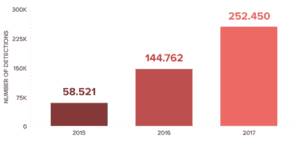
Danae Vara Borrell, vice president of product, Red Points
The shift in shoppers’ buying habits driven by the advent of e-commerce sites and social networks have drastically changed the way goods are being sold, marketed and bought. This is a change that hasn’t gone unnoticed by counterfeiters who have been ramping up their efforts on social networks in order to reach a wider audience.
Counterfeiters have perfected the art of agility, quickly recognizing which social media platform to sell each type of product, and how to market them in a way that resembles that of the real deal.
A good example of this can be seen on Instagram, where fake cosmetics products are hidden within branded hashtags, according to a 2016 study by cybersecurity researchers that showed a fifth to a third of the comments were from sellers of counterfeit products. Similarly, Red Points’ data revealed Facebook was increasingly a popular avenue for sale of fake football jerseys, with detections quadrupling in just two years.

Detected fake football jerseys on Facebook. Source: Red Points
With new fake listings popping up online in a matter of minutes, fighting counterfeits can often feel like playing a game of Whack-a-mole for brands. Traditionally, most companies have dealt with IP infringement or brand protection issues through in-house lawyers for lack of better alternatives. However, with sales on ecommerce marketplaces and social media platforms progressively dominating the retail landscape, these traditional solutions have rapidly been falling short of expectations.
The recent migration of counterfeiters en masse to social media represents a clear cultural shift—and one that brands can’t afford to turn a blind eye on for several reasons:
The potential reach available on social media is colossal. Facebook alone has well over two billion users, and as mobile technology continues to become more accessible, the number of people on social media will only increase.
Social media is becoming a primary shopping channel. Our research has shown that, across a number of different industries, consumers are already very receptive to the idea of purchasing items from social media.
Social media are increasingly adopting an ecommerce-led approach. Instagram recently launched a new checkout feature allowing brands to sell directly to shoppers from the platform. Facebook has also been championing this new e-commerce-led approach for quite some time with Facebook Marketplace—a community-oriented service which aims to bring regular people together to buy and sell on their platform. In China, millions of users conduct transactions through WeChat.
So, how can brands facing a high number of counterfeits on social media fight back?
The best solution needs to effectively measure and improve the way brands approach online counterfeiters. Having the right insights to make decisions becomes even more necessary when building a sustainable brand protection strategy.
Get the full picture
A single brand often suffers from a variety of problems related to IP infringement. For example, a brand may be having trouble with counterfeits on Chinese sites like Alibaba, but struggling on eBay with sellers using the brand’s trademarks in the listings. Additionally, the enforcement process varies from platform to platform, and each case can take a different amount of time to solve.
Having a clear idea of how each of the hundreds, or even thousands, of enforcement processes are being currently processed is important for brands to fully understand their main counterfeiting issues. In order to do so, using KPIs, metrics, and dashboards will empower brands to easily compare information, connect the dots between seemingly isolated incidents, and root-cause infringing issues.
Make informed decisions, not assumptions
When it comes to brand protection, having up-to-date information about online infringements enables brands to take accurate and timely decisions to stay effective. Ultimately, having the necessary data to back decisions allows companies to enhance their efficiency in detecting and enforcing online counterfeits.
Leverage technology
Besides these, leveraging AI technology can help address one of the biggest challenges borne out of the advent of the internet—mass online counterfeiting. The speed with which counterfeiters can now produce and advertise fakes has rendered traditional IP enforcement methods somewhat insufficient.
Automated removals can help speed up enforcement procedures in a cost-effective manner, and free up staff’s time to work on other tasks. When brand protection is automated, on average it can take as little as a few hours from detection of infringing content to takedown—a process that typically takes days or weeks when done manually.
Ultimately, though online counterfeit is showing little sign of slowing down, implementing a data-driven IP strategy and leveraging technology can come a long way in helping brands prioritize and make informed decisions to build a sustainable brand protection plan, and maximize their brand protection efforts. Being strategic by measuring and improving the way brands approach online counterfeiters will definitely support companies to succeed in the battle against fakes.
Red Points helps brands combat online counterfeiting and intellectual property infringement.
Favorite